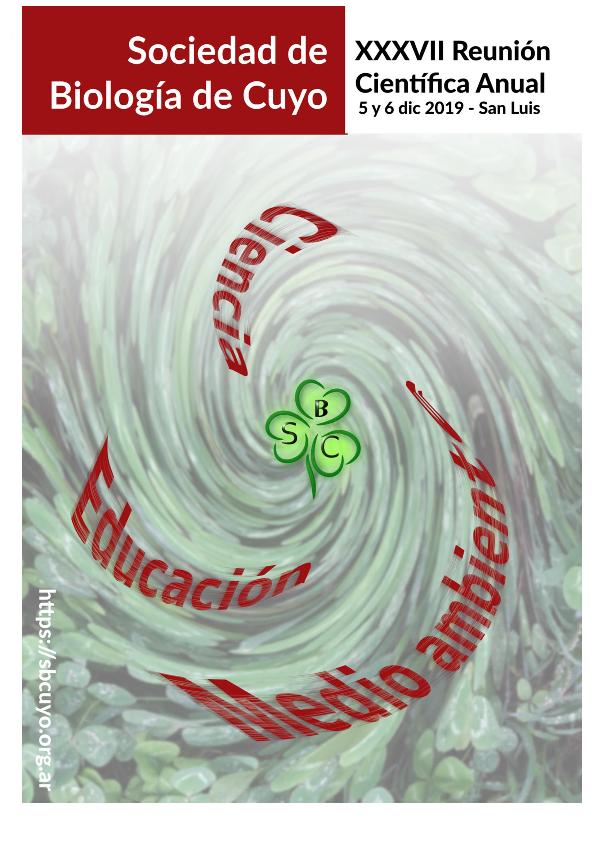Mostrar el registro sencillo del ítem
dc.contributor.author
Mastrodonato, Anna Chiara
dc.contributor.author
Favier Gabriela Isabel
dc.contributor.author
Lucero Estrada, Cecilia Stella Marys

dc.contributor.author
Escudero María Esther
dc.date.available
2023-06-02T16:36:27Z
dc.date.issued
2019
dc.identifier.citation
Assessment of virulence genotypic markers in Yersinia enterocolitica biotype 1A strains of different origins by PCR.; XXXVII Reunión Científica Anual de la Sociedad de Biología de Cuyo; San Luis; Argentina; 2019
dc.identifier.uri
http://hdl.handle.net/11336/199400
dc.description.abstract
Y. enterocolitica B1A comprise a heterogeneous group of strains that encompasses a wide variety of serotypes. They have been considered non-pathogenic microorganisms due to the lack of plasmid and chromosomal virulence determinants that characterize pathogenic strains; however, strains of this biotype are commonly reported not only from healthy individuals, but also from patients with gastrointestinal disorders. The comprehension of pathogenic mechanisms of B1A strains should focus on certain chromosomal virulence determinants associated to adhesion and invasion in intestinal cells (myfA and ail genes), production of heat-stable enterotoxin (ystB), some proteases (hreP) and iron chelating receptor (fepA), all of them related to growth and survival in host during infection. The synthesis of insecticidal toxins (tccC) is also considered a virulence determinant in Y. enterocolitica B1A. In this work, virulence-associated genes such as ystB (146 bp), myfA (272 bp), hreP (757 bp), fepA (438 bp) and tccC (1035 bp) were studied in 23 local Y. enterocolitica B1A strains of different origins (animal, food, environmental and human clinical samples) by PCR. Strains belonging to serotypes O:5 and O:7,8-8-8,19 (six isolates each), O:41,42-41,43 (four isolates), O:5-4,32-4,33 (three isolates), O:6,30-6,31 (two isolates), O:12,25-12,26 and NA (non-agglutinable/non-determined serotype) (one isolate each) were analyzed. DNA extraction was performed by the ―boiling‖ technique and the amplification products were revealed by agarose gel electrophoresis. The frequency of detection of these genes in decreasing order was: fepA and ystB (22/23), hreP (21/23), tccC (3/23) and myfA (1/23). Regarding the relationship between genes and serotypes, fepA, ystB and hreP genes were demonstrated in strains of all serotypes, meanwhile tccC was observed in O:41,42-41,43 and O:7,8-8-8,19 strains, and myfA was only detected in O:7,8-8-8,19 strains. The serotype O:7,8-8-8,19 was associated to the presence of all genes. Regarding the relationship between genes and strain sources, ystB, hreP and fepA were demonstrated in chicken samples (3 isolates), porcine products (five isolates), ground meat (six isolates), human clinical samples (three isolates), and wild boar, hake fillet and wastewater (one isolate each). The myfA gene was observed in porcine skin (one isolate) and tccC was present in porcine skin (two isolates) and wild boar (one isolate). Interestingly, human samples belonged to serotypes O:5 (two isolates) and O:7,8-8-8,19 (one isolate) showed to be carriers of most of the studied genes, except myfA and tccC. Our results suggest the existence of alternative virulence mechanisms in Y. enterocolitica B1A and that the pathogenic potential of this biotype might be strain-dependent.
dc.format
application/pdf
dc.language.iso
eng
dc.publisher
Sociedad de Biología de Cuyo
dc.rights
info:eu-repo/semantics/openAccess
dc.rights.uri
https://creativecommons.org/licenses/by-nc-sa/2.5/ar/
dc.subject
VIRULENCE MARKERS
dc.subject
YERSINIA ENTEROCOLITICA
dc.subject
BIOTYPE 1A
dc.subject
PCR
dc.subject.classification
Biología Celular, Microbiología

dc.subject.classification
Ciencias Biológicas

dc.subject.classification
CIENCIAS NATURALES Y EXACTAS

dc.title
Assessment of virulence genotypic markers in Yersinia enterocolitica biotype 1A strains of different origins by PCR.
dc.type
info:eu-repo/semantics/publishedVersion
dc.type
info:eu-repo/semantics/conferenceObject
dc.type
info:ar-repo/semantics/documento de conferencia
dc.date.updated
2022-11-09T19:45:01Z
dc.journal.pais
Argentina

dc.journal.ciudad
San Luis
dc.description.fil
Fil: Mastrodonato, Anna Chiara. Universidad Nacional de San Luis. Facultad de Química, Bioquímica y Farmacia. Área Microbiología; Argentina
dc.description.fil
Fil: Favier Gabriela Isabel. Universidad Nacional de San Luis. Facultad de Química, Bioquímica y Farmacia. Área Microbiología; Argentina
dc.description.fil
Fil: Lucero Estrada, Cecilia Stella Marys. Universidad Nacional de San Luis. Facultad de Química, Bioquímica y Farmacia. Área Microbiología; Argentina. Consejo Nacional de Investigaciones Científicas y Técnicas. Centro Científico Tecnológico Conicet - San Luis. Instituto Multidisciplinario de Investigaciones Biológicas de San Luis. Universidad Nacional de San Luis. Facultad de Ciencias Físico Matemáticas y Naturales. Instituto Multidisciplinario de Investigaciones Biológicas de San Luis; Argentina
dc.description.fil
Fil: Escudero María Esther. Universidad Nacional de San Luis. Facultad de Química, Bioquímica y Farmacia. Área Microbiología; Argentina
dc.relation.alternativeid
info:eu-repo/semantics/altIdentifier/url/https://sbcuyo.org.ar/wp-content/uploads/2019/12/Libro-de-resumenes-2019.pdf
dc.conicet.rol
Autor

dc.conicet.rol
Autor

dc.conicet.rol
Autor

dc.conicet.rol
Autor

dc.coverage
Nacional
dc.type.subtype
Jornada
dc.description.nombreEvento
XXXVII Reunión Científica Anual de la Sociedad de Biología de Cuyo
dc.date.evento
2019-12
dc.description.ciudadEvento
San Luis
dc.description.paisEvento
Argentina

dc.type.publicacion
Book
dc.description.institucionOrganizadora
Sociedad de Biología de Cuyo
dc.source.libro
Libro de Resúmenes del Congreso
dc.type
Jornada
Archivos asociados
